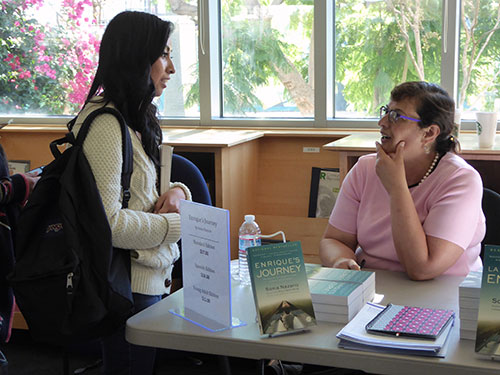
Sonia Nazario remembers exactly the moment she decided to become a journalist. She was 14 years old. She was walking down a street near her home in Buenos Aires, Argentina, with her mother when they saw a pool of blood on the sidewalk ahead of them.
It was the blood of two journalists killed by the military. Then and there, Nazario determined to become a journalist. And with that decision, she lived in fear everyday of disappearing herself.
“I decided that I was going to be a journalist–a truth teller,” the Pulitzer prize-winning writer told the audience in the library of Mission College, 3000 Mission College Blvd., Santa Clara, where she spoke Oct. 26.
“I increasingly understood how repressive regimes thrived by stifling the free flow of information,” she stated in an interview (www.enriquesjourney.com).
Nazario, whose parents had immigrated to the U.S. from Argentina, was born in Wisconsin and raised in Kansas until her father died. Then her mother moved back to Argentina with the family.
After graduating from college in the U.S. and working as a backup Latin American correspondent for the Wall Street Journal, Nazario decided to focus on writing about social issues in the U.S., giving voice to “people whose voices aren’t often heard…women, children, the poor, and immigrants,” said Nazario.
Nazario’s Los Angeles Times documentary series “Enrique’s Journey” was awarded a Pulitzer Prize for feature writing in 2003. It was then made into a book now widely read and studied in schools, including Mission College.
“Every college I go to, there are students who have lived the story I’m going to talk about,” said Nazario to the Mission College students, [faculty and guests who gathered to hear her speak at 11 a.m. and 7 p.m.]
“Enrique’s Journey” is the true story of a teenager from Honduras who made a dangerous journey through Guatemala by bus and then through Mexico by clinging to the top of freight trains, called “el tren de la muerte” (the train of death) and “la bestia” (the beast), attempting to enter the U.S. to find his mother. She had left him behind when he was five, to earn money to send to her children and had never returned. Enrique was 16-years-old and had not seen his mother for more than a decade.
To lend authenticity to her writing, Nazario had retraced Enrique’s journey not once but twice. She spent months riding freight trains, taking some of the same risks Enrique had faced–from the danger of riding atop a fast-moving train to the risk of attack by gangs.
“Reading ‘Enrique’s Journey’ has been eye-opening,” said Mission College Puente Program student Carlos Chavez, who introduced Nazario at the 11 a.m. presentation. He, too, had been left behind by his parents.
“Reading ‘Enrique’s Journey’ helps us understand where we’ve come from and appreciate what we have,” said Chavez.
At the end of her passionate 60-minute talk and power point presentation, Nazario addressed the long-term issue of determining and supporting U.S. policies to stem the exodus of unaccompanied minors at its sources–El Salvador, Guatemala, Honduras and Mexico. At the same time, she believes, the U.S. must examine the dangerous consequences of current policy in the lives of “the army of children” who now attempt to cross U.S. borders.
“There are moments in our history that are a test for all of us. Will we rise to the level of humanity required of us?” Nazario asked.
“Our institution creates awareness and opportunities by providing intentional programming for our students and entire Mission College community,” stated John Mosby, Vice President, Student Services. “Through inviting great speakers such as Sonia Nazario, the college hopes that our students can identify with the stories and journeys presented that will guide them in achieving their educational and career goals.”
Mission College (www.missioncollege.edu) serves over 25 percent Latino students.





